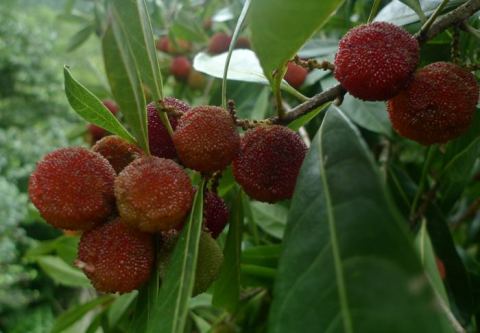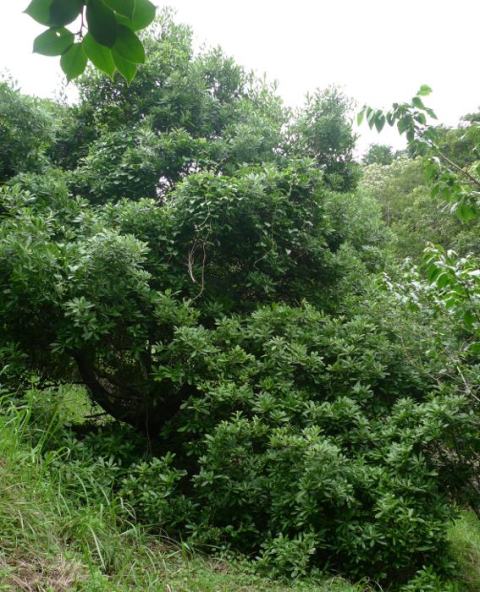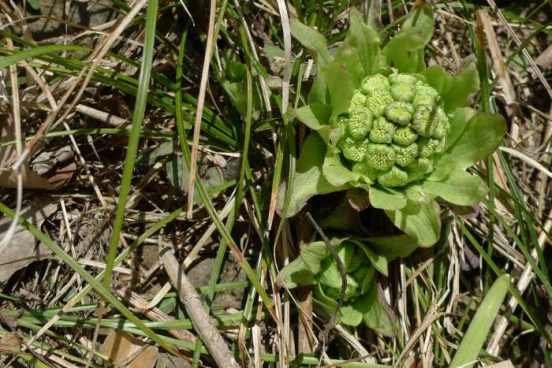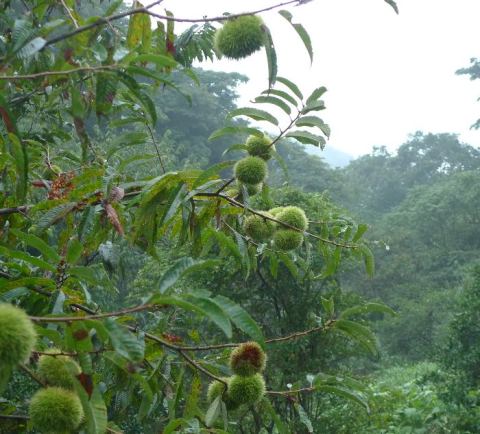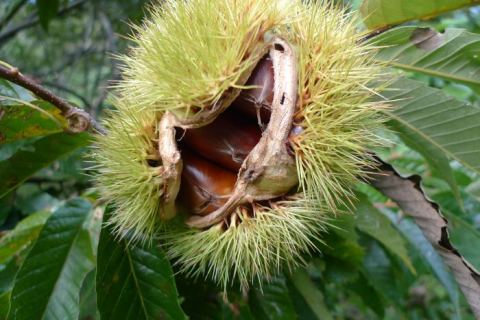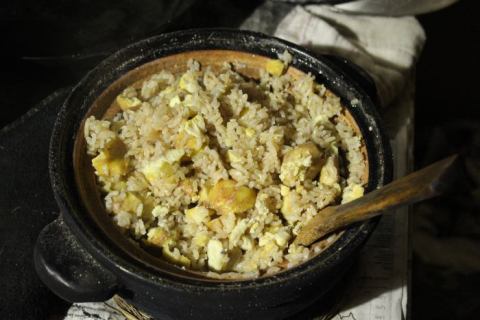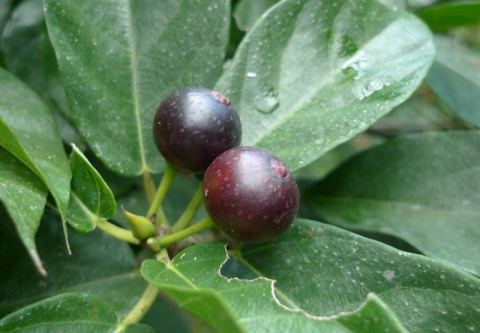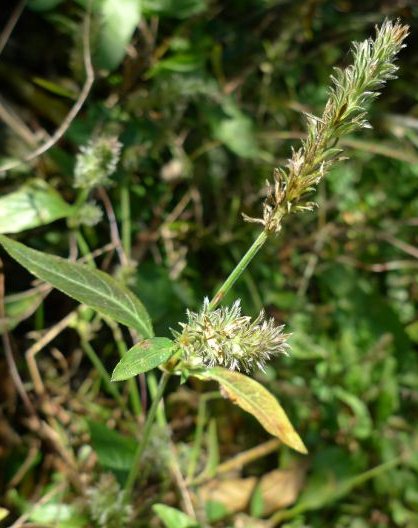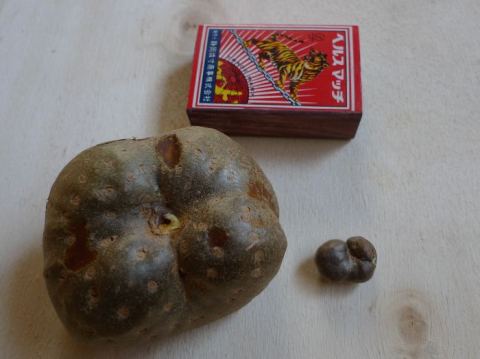Yamamomo
July 23, 2013
‘Tis the season for yamamomo (Myrica rubra), variously known to the English-speaking world as Chinese or Japanese bayberry, red bayberry, yumberry, Asian bog myrtle, Chinese strawberry tree or waxberry. Of these last two names the former comes from a resemblance to the strawberry tree (Arbutus unedo) and the latter because the fruit of other myrica species is coated in wax (from which candles can be made) and therefore they are known as wax myrtles or wax berries. However, despite sometimes being referred to as waxberry, the fruit of M. rubra does not have a waxy coating. A friend who lives without electricity (and thus always interested in potential sources of candle wax) has been wholly unsuccessful, despite her best attempts, in extracting any wax from M. rubra.
The Japanese name, yamamomo (山桃), means ‘mountain (yama 山) peach (momo 桃)’ although there is nothing very peach-like about the fruits of yamamomo. But then neither is there much peach-like about the native plums which are called sumomo (which once meant vinegar, or sour, (su 酸) peach (momo 桃)[1], although in contemporary Japanese sumomo is usually written 李 which obfuscates this older meaning). As far as I can see the only thing these other momo’s have in common with peaches is that they are round, stone fruits and usually red-ish.
The fruits of yamamomo are about 1.5 – 2 cm’s in diameter (there are cultivated varieties that have larger fruits however, according to local growers, the fruit is easily damaged by inclement weather at harvest time). The fruits grow in clusters and are dark red to purple when ripe. The tree is evergreen with leathery leaves and grey bark, reaching heights of 15 metres. It grows on forested mountain slopes (100 – 1500 metres) throughout southern China, Taiwan, Japan, Korea, the Philippines…[2]
The fruits are refreshingly tart and may be eaten fresh though often they are served in a sweet syrup. They also make wonderful wine (and if you can make wine you can, of course, make vinegar too). In both China and Japan they are used to make a medicinal liquor (steeped in báijiǔ in China and shōchū in Japan). See recipes below.
I have been told that, in the past, the seeds of yamamomo were also eaten in Japan. The seeds are “stones” like those of plums — although rather small they are very hard. I am yet to find out exactly how the seeds were rendered edible but I will surely update this post when I do.
The traditional medicinal uses of M. rubra by the peoples of east Asia include as an antidote for arsenic poisoning, a carminative, an anti-inflammatory, for the treatment of diarrhea, dysentery, dyspesia, nausea, excessive perspiration, psoriasis, and in the treatment of wounds, ulcers and sores.[3]
For the treatment of arsenic poisoning, wounds, sores and skin diseases a decoction of the stem bark is applied externally.[4]
The leaves have long been known to practitioners of Chinese medicine to be anti-inflammatory and recent studies have shown the juice of the fruits is also anti-inflammatory and effective in the treatment of ulcers.[5, 6]
_________________________________________________________________________________________________________
Yamamomo in syrup
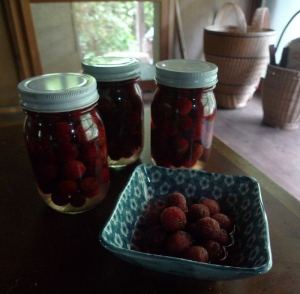 The few recipes for sweetened yamamomo that I have seen recommended cooking the fruit for 5 – 10 minutes in the syrup but I find this makes the fruit too mushy and it loses its wonderful tart edge. They also recommended an equal weight of sugar to that of the fruit – I say half that amount of sugar is plenty. I suspect these people don’t even like yamamomo!
The few recipes for sweetened yamamomo that I have seen recommended cooking the fruit for 5 – 10 minutes in the syrup but I find this makes the fruit too mushy and it loses its wonderful tart edge. They also recommended an equal weight of sugar to that of the fruit – I say half that amount of sugar is plenty. I suspect these people don’t even like yamamomo!
- Soak yamamomo in a salt brine for 30 minutes then rinse. This is to remove insects of which there are usually plenty.
- Bring sugar (half the weight of the fruit) to a boil in enough water to cover the fruit.
- Add the fruit and boil for just a couple of minutes.
- Put the fruit in jars and cover completely with the the syrup and screw on lids.
After about 24 hours they should be ready. Kept in a cool place they should keep for a month. If, once filled and capped, the jars are covered with hot water and boiled for 20 – 30 minutes the fruit should keep for up to a year. For more on processing for long term storage see here. I have attempted a batch with raw fruit — the yamamomo was not placed in the boiling syrup but directly in the jars and the hot syrup poured over the fruit — however, it started to ferment within a few days. Still tasted great though.
After finishing the fruit the syrup is used to make a very pleasant summer drink. Pour a little in the bottom of a glass and fill with cold water.
_________________________________________________________________________________________________________
Yamamomo Wine
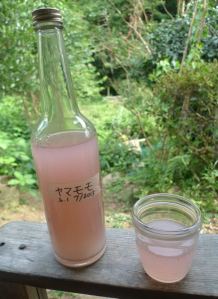 Yamamomo fruits are coated in wild yeasts which, if treated right, will happily make alcohol for you. And they’re so easy to please! Place the fruit in sugary water and stir often. As simple as that. How much sugar you use will affect the vigour and length of fermentation and thus the strength (alcohol content) of your brew. For a strong wine, use more. For 2kg of yamamomo I use about 1.25 kg’s of sugar. To make a simple “country wine” to be consumed “green”: [7]
Yamamomo fruits are coated in wild yeasts which, if treated right, will happily make alcohol for you. And they’re so easy to please! Place the fruit in sugary water and stir often. As simple as that. How much sugar you use will affect the vigour and length of fermentation and thus the strength (alcohol content) of your brew. For a strong wine, use more. For 2kg of yamamomo I use about 1.25 kg’s of sugar. To make a simple “country wine” to be consumed “green”: [7]
- Do not wash the yamamomo. You want to keep all the wild yeast on the fruit. Yes, there probably will be many tiny insects in the fruit but these will be strained out later. Place the fruit in the bottom of a container – a food grade plastic bucket or large glass jar will do nicely.
- Dissolve the sugar in enough cold water to generously cover the fruit (5 to 10 cm’s is good). Pour this mixture over the fruit in the bucket.
- Stir. And stir often. The more you can stir your potion the better. I stir my concoctions anywhere from 6 to 10 times a day. At a minimum give it at least four good stirrings every day.
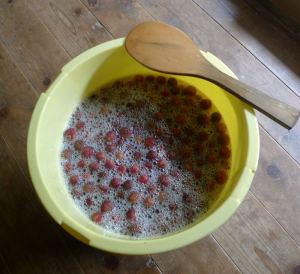
- Between stirring keep your bucket covered with a lid, cloth or anything else that keeps flies and dust out.
- After a day or two you should see bubbles or froth forming on the top of the liquid. Keep up the daily stirrings until the froth begins to lessen – hopefully this will take a couple of weeks.
- When fermentation does begin to subside strain in to bottles and enjoy.
_________________________________________________________________________________________________________
Yamamomo vinegar
Vinegar is essentially wine that has been overexposed to oxygen. Once the yeasts that converted the sugars to alcohol have begun to lose steam through lack of food acetobacter (acetic-acid-producing bacteria who were always present but until now held in check by the vigour of the yeasts) begin to dominate. It is acetobacter that will turn your wine in to vinegar.
So, to make vinegar follow the wine making steps listed above but rather than bottling the finished wine strain it into another wide mouthed container and keep covered with a cloth. Taste regularly and when it reaches the desired acidity (when it tastes like vinegar) bottle and cap. A vinegar ‘mother’ may have formed on top which you’ll need to remove before bottling. But don’t discard this. You can eat it, feed to it to your chickens or compost it.
_________________________________________________________________________________________________________
Yamamomo Koubo
Given that yamamomo is abundantly covered in wild yeasts (kõbo) it can also be used as a yeast source for bread (and probably beer too). Place some fruit in a jar, cover with water and add some honey or sugar. Stir or shake the jar often (if shaking release pressure by opening the lid after shaking). When it begins to bubble vigorously it is ready to use. For bread, just add some of the liquid to your dough mix. A little experimentation may be needed to get the amount right.
_________________________________________________________________________________________________________
Yamamomo shochu
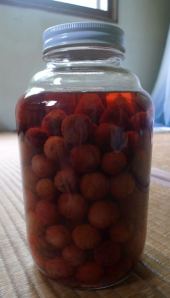 Simply steep yamamomo in liquor for a month or more. Here in Japan shōchū is typically used, in China it is báijiǔ and in Korea soju. These are all white liquors usually ranging from around 35 – 60% alcohol by volume. Vodka would be an obvious substitute. If you’re concerned about little insects in your alcohol soak the fruit in a salt brine for 30 minutes then rinse. Place the fruit in a jar and cover with liquor of your choice.
Simply steep yamamomo in liquor for a month or more. Here in Japan shōchū is typically used, in China it is báijiǔ and in Korea soju. These are all white liquors usually ranging from around 35 – 60% alcohol by volume. Vodka would be an obvious substitute. If you’re concerned about little insects in your alcohol soak the fruit in a salt brine for 30 minutes then rinse. Place the fruit in a jar and cover with liquor of your choice.
If your focus is on extracting the medicinal qualities of yamamomo then what you are making is a tincture. Fill your jar with as much fruit as possible before adding the liquor. Let it sit for at least one month and keep it out of direct sunlight. Shaking it around a bit from time to time is not a bad idea either.
If, on the other hand, you just want to flavour some liquor for drinking then less fruit/more liquor can be used.
______________________________________________________________________________________________________
References
1. https://ja.wikipedia.org/wiki/スモモ. Accessed 7/19/2013.
2. Flora of China Vol. 4. Available online at efloras.org. Accessed 7/20/2013.
3. Dr. Duke’s Phytochemical and Ethnobotanical Databases. Accessed 7/23/2013.
4. Plants for a Future, Myrica rubra. Accessed 7/23/2013.
5. Wang, S.J., et al., ‘Anti-inflammatory activity of myricetin isolated from Myrica rubra leaves.’ Planta Med 76(14), October 2010.
6. Alajmi et al., ‘Some pharmacological actions of Myrica rubra.’ African Journal of Pharmacy and Pharmacology Vol. 7(9), 8 March, 2013. PDF from Academicjournals.org. Accessed 7/23/2013.
7. For more on making country wines (or any other fermentation technique for that matter) see Sandor Katz, The Art of Fermentation. Chelsea Green, 2012.
Let it Bleed
February 18, 2013
Originally posted on Les Chroniques Purple, February 16, 2013.
During a recent spell of particularly warm days a paper wasp appeared on the toilet wall. In subsequent days the temperature plummeted and (if she has moved at all) her movements have been barely perceptible. Coaxed from hibernation by the arrival of spring. Or, maybe not…
Although the sun rises higher in the sky with each passing day the nights remain crisp—cold clear skies and shimmering stars. This cold dark energy has dominated the past months. During this time many plants concentrate their vital energy, their ki, in root systems sunk deep in the relatively warm soil. There are also plants that have hugged the ground closely protecting themselves from the brutal wind that whips up the valley. Now, here and there, fukinoto, the small buds of the giant butterbur, have begun popping up from the ground. Fukinoto we deep fry or boil and mix with miso paste. It is a bitter tasting plant. The bitterness of many spring wild edible plants stimulates the digestive system and helps flush out the residue accumulated through the winter’s heavier fare. Fukinoto is a plant that reminds us of winters passing and the arising of spring.
It is a commonplace that farmers or those who “live close to the land” are more keenly attuned to the seasons. For us, living as foragers and gardeners in a forest, what we have become more aware of is the bleeding boundaries of the seasons across time and space. Spring, summer, autumn and winter as discrete seasons with “official” starting dates—be they astronomical or calendar-based—seem to have little to do with the dynamic flow of constant and gradual change that we experience. The drum roll of spring beginning somewhere in the depths of winter. The fall crescendo building momentum in the torrid days of summer.
During February—usually the coldest month—the morning ground glistens with a carpet of frost. The chickens struggle to drink water through the crust of ice that covers their bowl during the frigid nights. Winter scenes to be sure. However, late morning, as the sun crests over the mountains to the south, a warm glow fills the valley and a different scene is revealed. The tiny white flowers of chickweed peek out from the plants’ increasingly lush growth. Thousands of frog eggs become visible (how long have they been there?) on the bottom of a small pond. The first tentative blooms appear in the tree canopy.
Behind our house a path cuts across the slope of the hill. Above the path, where the sun hits early, where a bamboo grove shelters the land from strong winds, where the slope of the hillside encourages frost to move along without settling, daffodils have been glorying in days of spring for weeks already. It is here that the florets of nabana, a wild mustard, can be picked first. Below the path, in the depths of the valley, where the sun comes late, where the land is fully exposed to the gales and where frost settles thickly it is still the midst of winter. Here the nabana will arrive much later but will continue producing delicious florets for much longer.
For the forager attuning to the seasons, or “eating seasonally,” is a deep practice. It is an invitation to learn the lay of the land intimately; to learn the precise gradients in temperature caused by the differing angles of the sun as it touches a hillside; to develop a sense of the microclimates offered by a rocky outcrop, a tree, a body of water; to observe where the soil is most, or least, fertile. We overlay this information with what we have learned from the plants: preferences in soil fertility and warmth, preferences in amount of sunlight exposure relative to air temperature, how much rain in which temperature range will spur the fruiting of a particular fungi… Of course this is not to be studied in books then applied in the field but learned by doing, slowly. And anyway, it can hardly be said that it is consciously applied at all but rather, in a most subtle way, the feet, the eyes, the hands are guided.
– Asako Kitaori & Dion Workman
